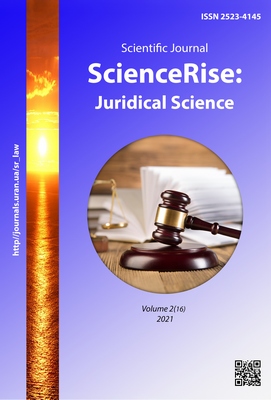Peculiarities of application of the practice of the European Court of Human Rights in the justice in Ukraine
DOI:
https://doi.org/10.15587/2523-4153.2021.235130Keywords:
European Court of Human Rights, Convention for the Protection of Human Rights and Fundamental Freedoms, justice, decisionsAbstract
The scientific article examines the activities of the European Court of Human Rights and identifies the significance of the relevant case law of the European Court for the case law of Ukraine. It is noted, that one of the issues, studied within the topic, is the sources and legal framework, which is especially relevant in the adoption of the Law of Ukraine «On Enforcement of Decisions and Application of the Case Law of the European Court of Human Rights», according to which courts use the Agreement and case law as a legal source in cases. The activity of the European Court of Human Rights, the role and impact on the judicial system of Ukraine are analyzed, the relevant examples are given. It is concluded, that the implementation of international human rights law into Ukrainian law is a complex procedure that requires special doctrinal consideration, as today Ukrainian citizens are among the most active complainants to the European Court of Human Rights, which indicates a fairly high insecurity by national legal mechanisms. In order to increase the credibility of the judiciary, courts should take into account the European experience, decisions and observations of the Court in their work. The Court's case law is said to play an important role in the judicial reform process as it approaches the European legal framework for human rights standards in Europe. The current law cannot fully protect a person or build justice if it is not applied properly. Based on existing ECtHR rulings, judges can accurately understand the rule of law and apply it properly, which will help improve human rights, accurate understanding and implementation of the Agreement on Ukraine. Based on the study, it was concluded, that it is necessary and appropriate to implement the decisions of the European Court of Human Rights, as in this way it is possible to ensure the protection and defense of human and civil rights and freedoms
References
- de Londras, F. (2012). Dual Functionality and the Persistent Frailty of the European Court of Human Rights, European Human Rights Law Review, 1, 38–46.
- Maurice, A., Bomhoff, J. (Eds.) (2012). Practice and theory in comparative law. Cambridge: Cambridge University Press. doi: http://doi.org/10.1017/cbo9780511863301
- Gerards, J. (2018). Margin of Appreciation and Incrementalism in the Case Law of the European Court of Human Rights. Human Rights Law Review, 18 (3), 495–515. doi: http://doi.org/10.1093/hrlr/ngy017
- Kumm, M. (2004). The Legitimacy of International Law: A Constitutionalist Framework of Analysis. European Journal of International Law, 15 (5), 907–931. doi: http://doi.org/10.1093/ejil/15.5.907
- Longer-Term Future of the System of the European Convention on Human Rights. Report of the Steering Committee for Human Rights. Council of Europe. Available at: https://www.coe.int/en/web/human-rights-intergovernmental-cooperation/echr-system/future-of-convention-system
- Konventsiia pro zakhyst prav liudyny i osnovopolozhnykh svobod (1997). Konventsiiu ratyfikovano Verkhovnoiu Radoiu Ukrainy Zakonom No. 475/97-VR 17.07.1997. Available at: http://zakon5.rada.gov.ua/laws/show/995_004
- Selivanov, A. O. (2006). Pravo tlumachyty zakony ta yurydychni naslidky zastosuvannia ofitsiinoi interpretatsii. Visnyk Verkhovnoho Sudu Ukrainy, 7, 2–6.
- Lukianenko, D. O., Bilodid, I. M. (2018). Zastosuvannia praktyky Yevropeiskoho sudu z prav liudyny v diialnosti orhaniv prokuratury. Praktyka Yevropeiskoho sudu z prav liudyny v diialnosti orhaniv prokuratury i sudu: vyklyky ta perspektyvy. Kyiv: Natsionalna akademiia prokuratury Ukrainy, 117–119.
- De Salvia, M. (2004). Pretsedenty Evropeyskogo Suda po pravam cheloveka. Rukovodyaschie printsipy sudebnoy praktiki, otnosyaschiesya k evropeyskoy Konventsii o zaschite prav cheloveka i osnovnykh svobod. Sudebnaya praktika s 1960 po 2002 g. Saint Petersburg: Yuridicheskiy tsentr Press, 1072.
- Vitruk, N. V. (2006). O nekotorykh osobennostyakh ispolzovaniya resheniy Evropeyskogo suda po pravam cheloveka v praktike Konstitutsionnogo Suda Rossiyskoy Federatsii i inykh sudov. Implementatsiya resheniy Evropeyskogo suda po pravam cheloveka v praktike konstitutsionnykh sudov stran Evropy. Moscow, 183–193.
- Pro vykonannia rishen ta zastosuvannia praktyky Yevropeiskoho sudu z prav liudyny (2006). Zakon Ukrainy No. 3477-IV. 23.02.2006. Vidomosti Verkhovnoi Rady Ukrainy, 30, 260.
- Ilchenko, I. M. (2009). The implementation of the 1950 European Convention on Human Rights and the case-law of the European Court of Human Rights: international – legal analysis of Governments practice. Naukovyi visnyk Dyplomatychnoi akademii Ukrainy, 15, 311–318.
- Shevchuk, S. (2007). Sudova pravotvorchist: svitovyi dosvid i perspektyvy v Ukraini. Kyiv: Referat, 640.
- Tammer v. Estonia no. 41205/98. Available at: https://sip.lex.pl/orzeczenia-i-pisma-urzedowe/orzeczenia-sadow/41205-98-tammer-v-estonia-decyzja-europejskiego-520618633
- Fuchs v. Poland no. 33870/96. Available at: https://sip.lex.pl/orzeczenia-i-pisma-urzedowe/orzeczenia-sadow/33870-96-fuchs-v-polska-wyrok-europejskiego-trybunalu-520168445
- Svyato-Mykhaylivska parafiya v. Ukraine no. 77703/01 Available at: https://hudoc.echr.coe.int/fre#{%22itemid%22:[%22002-2667%22]}
- Bushchenko, A. et. al. (2014). Sudovi spravy, yaki zminiuiut Ukrainu. Ukrainska Helsinska spilka z prav liudyny. Tsentr informatsii pro prava liudyny. Kyiv, 36.
- Shevchuk, C. V. (2000). Shchodo oboviazkovosti rishen Konstytutsiinoho Sudu Ukrainy u konteksti doktryny sudovoho pretsedentu. Pravo Ukrainy, 2, 45–48.
Downloads
Published
How to Cite
Issue
Section
License
Copyright (c) 2021 Andrii Rybalkin, Yuliia Nosenko

This work is licensed under a Creative Commons Attribution 4.0 International License.
Our journal abides by the Creative Commons CC BY copyright rights and permissions for open access journals.
Authors, who are published in this journal, agree to the following conditions:
1. The authors reserve the right to authorship of the work and pass the first publication right of this work to the journal under the terms of a Creative Commons CC BY, which allows others to freely distribute the published research with the obligatory reference to the authors of the original work and the first publication of the work in this journal.
2. The authors have the right to conclude separate supplement agreements that relate to non-exclusive work distribution in the form in which it has been published by the journal (for example, to upload the work to the online storage of the journal or publish it as part of a monograph), provided that the reference to the first publication of the work in this journal is included.









